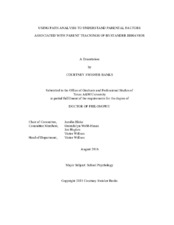| dc.description.abstract | Due to the negative effects of bullying, schools have worked to address bullying by adopting anti-bullying prevention programs and policies that include parental components in order to increase student generalization of effective strategies to reduce bullying. Recently, school anti-bullying interventions have focused on increasing appropriate bystander responses, especially because the person or persons that witness bullying can disrupt the frequency of the incidents by deciding to intervene and support the victim. However, according to the social-ecological perspective, children can choose to adopt bystander responses based not only on what they learn in school, but also on what their parents teach them to do.
Due to the research indicating that parent teachings to their victimized children can vary by several factors, it seems plausible that parent teachings on what to do when their child is a bystander can vary by their perceptions of their child’s school. Using path analysis, the current study examines if parental perceptions of school climate and awareness of anti-bullying interventions impact what parents teach their children to do as bystanders. Results indicated a failed model, with only six of the ten directional paths in the correct direction. There was a significant and positive relationship between parent and school counselor correspondence of anti-bullying interventions and parents teaching their children to stand up for the victim when bullying is witnessed at school. Results also revealed that parent perception of school climate was negatively related to parents teaching their child to tell an adult when witnessing bullying. Possible factors influencing the model, strategies to promote home and school collaborations on anti-bullying initiatives, and future directions are discussed. | en |


